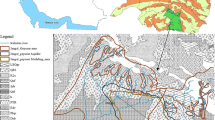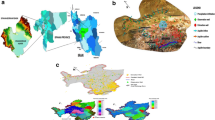Abstract
Considering the different quantitative and qualitative issues of groundwater resources, which are caused by population growth and development, the implementation of comprehensive plans and taking management measures in order to protect and restore groundwater resources are highly recommended. In this regard, the evaluations of various management measures are necessary because based on the results, it is possible to make appropriate decisions about how to control water consumption as the main part of future policies. Hashtgerd study area is located in Alborz province in Iran and requires appropriate decisions regarding how to control the intensive groundwater resources depletion and quality reduction. An average storage deficit of 4.08 million cubic meters per year was realized during 2012–2016 and water quality decreased. The present study has investigated the quantitative and qualitative changes of groundwater resources using MODFLOW and MT3DMS in response to different management schemes. Different management schemes based on a national plan called “the aquifer restoration plan” were applied for the 20-year horizon (2016–2036). It was found that by blocking unlicensed agricultural wells and modifying the licenses for licensed agricultural wells in the entire aquifer area, the storage would increase by an average of 7.23 million cubic meters per year, and nitrate and sulfate concentrations would decrease by 0.06 and 1.14 mg/l per year, respectively. Artificial recharge of the aquifer with treated wastewater was found to have a great impact on reducing pollutants and improving the water quality, though it had no desirable effect on the groundwater level. In this case, nitrate and sulfate concentrations decrease by 0.53 and 2.24 mg/l per year, respectively.











Similar content being viewed by others
Data availability
Not applicable.
Code availability
Not applicable.
References
Beegum, S., Šimůnek, J., Szymkiewicz, A., Sudheer, K. P., & Nambi, I. M. (2018). Updating the coupling algorithm between HYDRUS and MODFLOW in the HYDRUS package for MODFLOW. Vadose Zone Journal, 17(1), 1–8.
Beegum, S., Vanderborght, J., Šimůnek, J., Herbst, M., Sudheer, K. P., & Nambi, I. M. (2020). Investigating atrazine concentrations in the Zwischenscholle aquifer using MODFLOW with the HYDRUS-1D package and MT3DMS. Water. https://doi.org/10.3390/W12041019
Daughton, C. G., & Ternes, T. A. (1999). Pharmaceuticals and personal care products in the environment: Agents of subtle change? Environmental Health Perspectives, 107(suppl 6), 907–938.
Doherty, J. (2005). PEST model-independent parameter estimation user manual. Watermark Numerical Computing.
Ehteshami, M., Langeroudi, A. S., & Tavassoli, S. (2013). Simulation of nitrate contamination in groundwater caused by livestock industry (case study: Rey). Journal of Environmental Protection, 4(7), 97.
Ehtiat, M., Jamshid Mousavi, S., & Srinivasan, R. (2018). Groundwater modeling under variable operating conditions using SWAT, MODFLOW and MT3DMS: A catchment scale approach to water resources management. Water Resources Management. https://doi.org/10.1007/s11269-017-1895-z
Eltarabily, M. G., Negm, A. M., Yoshimura, C., & Saavedra, O. C. (2017). Modeling the impact of nitrate fertilizers on groundwater quality in the southern part of the Nile Delta. Egypt Water Science and Technology: Water Supply, 17(2), 561–570.
Gejl, R. N., Bjerg, P. L., Henriksen, H. J., Bitsch, K., Troldborg, L., Schullehner, J., Rasmussen, J., & Rygaard, M. (2020). Relating wellfield drawdown and water quality to aquifer sustainability—A method for assessing safe groundwater abstraction. Ecological Indicators. https://doi.org/10.1016/j.ecolind.2019.105782
Ghadimi, S., & Ketabchi, H. (2019). Possibility of cooperative management in groundwater resources using an evolutionary hydro-economic simulation-optimization model. Journal of Hydrology. https://doi.org/10.1016/j.jhydrol.2019.124094
Harbaugh, A. W. (2005). MODFLOW-2005, the US geological survey modular ground-water model: The ground-water flow process (Vol. 6). US Department of the Interior US Geological Survey Reston.
Hariharan, V., & Shankar, M. U. (2017). A review of visual MODFLOW applications in groundwater modelling. IOP Conference Series: Materials Science and Engineering, 263, 32025.
Jalut, Q. H., Abbas, N. L., & Mohammad, A. T. (2018). Management of groundwater resources in the Al-Mansourieh zone in the Diyala River Basin in Eastern Iraq. Groundwater for Sustainable Development, 6, 79–86.
Ketabchi, H., & Ataie-Ashtiani, B. (2015a). Assessment of a parallel evolutionary optimization approach for efficient management of coastal aquifers. Environmental Modelling & Software, 74, 21–38.
Ketabchi, H., & Ataie-Ashtiani, B. (2015b). Coastal groundwater optimization—advances, challenges, and practical solutions. Hydrogeology Journal, 23(6), 1129–1154.
Kheirandish, M., Rahimi, H., Kamaliardakani, M., & Salim, R. (2020). Obtaining the effect of sewage network on groundwater quality using MT3DMS code: Case study on Bojnourd plain. Groundwater for Sustainable Development. https://doi.org/10.1016/j.gsd.2020.100439
Kurwadkar, S., Kanel, S. R., & Nakarmi, A. (2020). Groundwater pollution: Occurrence, detection, and remediation of organic and inorganic pollutants. In Water Environment Research. https://doi.org/10.1002/wer.1415
la Cecilia, D., Porta, G. M., Tang, F. H. M., Riva, M., & Maggi, F. (2020). Probabilistic indicators for soil and groundwater contamination risk assessment. Ecological Indicators. https://doi.org/10.1016/j.ecolind.2020.106424
Marnani, S. A., Chitsazan, M., Mirzaei, Y., & Jahandideh, B. (2010). Groundwater resources management in various scenarios using numerical model. American Journal of Geoscience, 1(1), 21.
Miao, Z., Brusseau, M. L., Carroll, K. C., Carreón-Diazconti, C., & Johnson, B. (2012). Sulfate reduction in groundwater: Characterization and applications for remediation. Environmental Geochemistry and Health, 34(4), 539–550. https://doi.org/10.1007/s10653-011-9423-1
Mirzaee, M., Safavi, H. R., Taheriyoun, M., & Rezaei, F. (2021). Multi-objective optimization for optimal extraction of groundwater from a nitrate-contaminated aquifer considering economic-environmental issues: A case study. Journal of Contaminant Hydrology, 241, 103806.
MOE (Ministry of Energy). (2011). Semi-detailed studies of Hashtgerd plain, groundwater report.
MOE (Ministry of Energy). (2013). Updating water resources studies report of Namak Lake basin, Hashtgerd study area water balance report.
MOE (Ministry of Energy). (2014). Aquifer restoration plan.
MOE (Ministry of Energy). (2017). Justification report: Proposing to continue the ban on the development of water resources exploitation in Hashtgerd study area.
Mostafaei-Avandari, M., Ketabchi, H., & Shaker-Soureh, F. (2023). Managerial sustainability indices for improving the coastal groundwater decisions by a parallel simulation–optimization model. Environmental Monitoring and Assessment, 195(1), 100.
Ostad-Ali-Askari, K., & Shayannejad, M. (2021). Quantity and quality modelling of groundwater to manage water resources in Isfahan-Borkhar Aquifer. Environment, Development and Sustainability, 1, 1–17.
Podlasek, A., Bujakowski, F., & Koda, E. (2020). The spread of nitrogen compounds in an active groundwater exchange zone within a valuable natural ecosystem. Ecological Engineering. https://doi.org/10.1016/j.ecoleng.2020.105746
Poor-Tabari, M., Morsali, M., Noori, H. (2008). Site selection of artificial recharge aquifer projects using geographic information system, case study; Hashtgerd Plain.
Saghi-Jadid, M., & Ketabchi, H. (2021). Result-based management approach for aquifer restoration problems using a combined numerical simulation–parallel evolutionary optimization model. Journal of Hydrology, 594, 125709.
Schwarzenbach, R. P., Escher, B. I., Fenner, K., Hofstetter, T. B., Johnson, C. A., Von Gunten, U., & Wehrli, B. (2006). The challenge of micropollutants in aquatic systems. Science, 313(5790), 1072–1077.
Shahbazi, A., Safari, F., & Ketabchi, H. (2020). Modeling of management measures taken to control groundwater level depletion (Hashtgerd Plain, Alborz Province). Iran Water Resoures, 16(1), 116–134.
Shultz, C. D., Bailey, R. T., Gates, T. K., Heesemann, B. E., & Morway, E. D. (2018). Simulating selenium and nitrogen fate and transport in coupled stream-aquifer systems of irrigated regions. Journal of Hydrology, 560, 512–529.
Sidiropoulos, P., Tziatzios, G., Vasiliades, L., Mylopoulos, N., & Loukas, A. (2019). Groundwater nitrate contamination integrated modeling for climate and water resources scenarios: The case of Lake Karla over-exploited aquifer. Water, 11(6), 1201.
Sieczka, A., & Koda, E. (2016). Identification of nitrogen compounds sorption parameters in the soil–water environment of a column experiment. Ochrona Srodowiska, 38(3), 29–34.
Sieczka, A., Bujakowski, F., Falkowski, T., & Koda, E. (2018). Morphogenesis of a floodplain as a criterion for assessing the susceptibility to water pollution in an agriculturally rich valley of a lowland river. Water, 10(4), 399.
Taheri Tizro, A., Sarhadi, B., & Mohamadi, M. (2018). MODFLOW/MT3DMS based modeling leachate pollution transfer in solid waste disposal of Bahar plain deep aquifer. Iranian Journal of Health Sciences, 6(2), 11–30.
United Nations Statistics Division. (2012). SEEA-water system of environmental-economic accounting for water.
Zhang, H., Yang, R., Wang, Y., & Ye, R. (2019). The evaluation and prediction of agriculture-related nitrate contamination in groundwater in Chengdu Plain, southwestern China. Hydrogeology Journal. https://doi.org/10.1007/s10040-018-1886-z
Zheng, C., & Wang, P. P. (1999). MT3DMS: A modular three-dimensional multispecies model for simulation of advection, dispersion and chemical reactions of contaminants in groundwater systems, Documentation and User’s Guide. Contract Rep. SERDP-99–1, U.S. Army Eng. Res. and Dev. Cent., Vicksbrug, Miss.
Acknowledgements
The authors appreciate the constructive comments of two reviewers and Editor-in-Chief Prof. Luc Hens, who helped to improve the final version of the paper. Also, the authors are very grateful to Mr. Farshid Safari for helping to develop the MODFLOW for the study area used in this research.
Funding
The authors declare that no funds, grants, or other support were received during the preparation of this paper.
Author information
Authors and Affiliations
Contributions
All authors contributed to the study conception and design. Conceptualization, methodology, software, visualization, and writing was performed by SR. Project administration, supervision, conceptualization, methodology, investigation, software, resources, validation, and review & editing was done by HK. TE supervised the research. All authors read and approved the final paper.
Corresponding author
Ethics declarations
Conflict of interest
The authors declare no conflict of interest.
Ethics approval
Not applicable.
Consent to participate
Not applicable.
Consent for publication
Not applicable.
Additional information
Publisher's Note
Springer Nature remains neutral with regard to jurisdictional claims in published maps and institutional affiliations.
Supplementary Information
Below is the link to the electronic supplementary material.
Rights and permissions
Springer Nature or its licensor (e.g. a society or other partner) holds exclusive rights to this article under a publishing agreement with the author(s) or other rightsholder(s); author self-archiving of the accepted manuscript version of this article is solely governed by the terms of such publishing agreement and applicable law.
About this article
Cite this article
Rajaeian, S., Ketabchi, H. & Ebadi, T. Investigation on quantitative and qualitative changes of groundwater resources using MODFLOW and MT3DMS: a case study of Hashtgerd aquifer, Iran. Environ Dev Sustain 26, 4679–4704 (2024). https://doi.org/10.1007/s10668-022-02904-4
Received:
Accepted:
Published:
Issue Date:
DOI: https://doi.org/10.1007/s10668-022-02904-4




